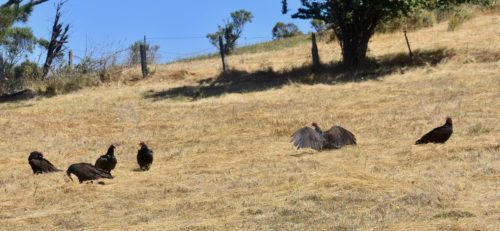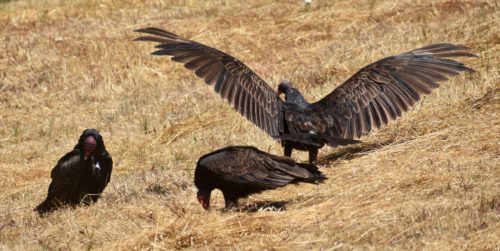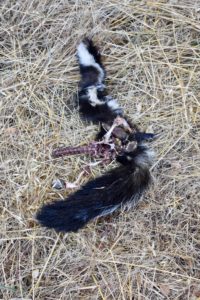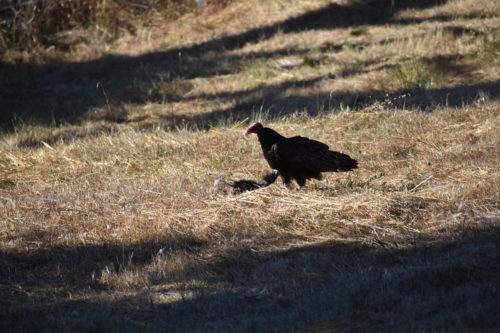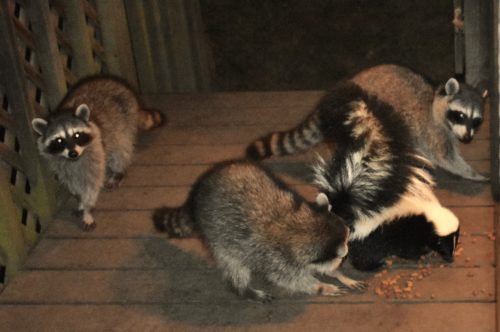Entries tagged with “vultures”.
Did you find what you wanted?
Fri 7 Jan 2022
Caveat lectorem: When readers submit comments, they are asked if they want to receive an email alert with a link to new postings on this blog. A number of people have said they do. Thank you. The link is created the moment a posting goes online. Readers who find their way here through that link can see an updated version by simply clicking on the headline above the posting.
This is a belated review of an entertaining linguistic book, A Charm of Goldfinches and Other Wild Gatherings. It was originally published five years ago by Ten-Speed Press. My wife Lynn gave it to me for Christmas. The author, Matt Sewell, is a Canadian ornithologist, illustrator, and artist who has exhibited in London, Manchester, New York, Tokyo, and Paris.

As most of us know, a group of geese is called a “gaggle” but if the geese are flying in formation, the proper term is “skein,” writes Sewell. The term “comes from an old French word for ‘V’ Formation.”

Some group names are grim but accurate. Here a “wake” of vultures divvy up a skunk killed by an owl.

Virtually every night at Mitchell cabin we can hear a “band” of coyotes howling.
Groups of coyotes are called “bands” although to my mind, “choirs” would be more accurate. Sewell notes that “outside of their guarded family units, coyotes hang together in unrelated gangs, scavenging and doing whatever coyotes do.”

A “sulk” of foxes atop a shed at Toby’s Feed Barn. These were spotted by postal staff outside a postoffice window.

A “plague” of rats. Given my recent experience with roof rats, I would second the group name “plague.” Roof rats found their way into my car’s engine compartment around Christmas and chewed wiring, piled up debris, and damaged the car’s computer. The final tab at garages in Point Reyes Staton and Santa Rosa to repair the damage came to more than $2,500.

A “trip” of rabbits.
Sewell frequently indulges his ironic sense of humor. Describing how groups of rabbits came to be called “trips,” Sewell writes: “Now, some of you may be thinking: the trip would be to follow the white rabbit down the rabbit hole. Â Sadly not: this term is from the 15th century, not the 1960s Jefferson Airplane lyric, or even Lewis Carroll’s Alice in Wonderland, which inspired the song. It is, in fact, about as psychedelic as a turnip patch.
“A colony of rabbits is a flighty bunch, not surprisingly, as the whole world is their enemy…. They are rarely safe for long, not when they’re hunted by hawks and owls, weasels, foxes, domestic pets, and humans, to name just a few.”
As noted previously, “jackrabbit” is short for “jackass rabbit,” a nickname it got because of its ears.
A “ lounge” of lizards. This is a blue-belly lizard on the wall of our cabin.
lounge” of lizards. This is a blue-belly lizard on the wall of our cabin.
Lizards are cold-blooded “so they need to warm up from the sun or on warm stones.”
“It’s this lounging that gets them into trouble though as lizards are easy prey in this laid-back state.
“If they are cruelly snatched, lizards at least have a last-gasp mechanism for freedom: they can release their tail, which will wriggle around in the predator’s mouth, confusing the daylights out of it while the lizard makes a dash for the undergrowth.”
I hope it gets there safely.
Wed 15 Jul 2020
Posted by DavidMitchell under Photography, Point Reyes Station, West Marin nature, Wildlife
Comments Off on Owls, buzzards, and other skunk eaters
Caveat lectorem: When readers submit comments, they are asked if they want to receive an email alert with a link to new postings on this blog. A number of people have said they do. Thank you. The link is created the moment a posting goes online. Readers who find their way here through that link can see an updated version by simply clicking on the headline above the posting.

Six buzzards landed on the hill above Mitchell cabin last Saturday, immediately letting Lynn and me know that something had died.

We could see one buzzard tearing away at a carcass. But of what?
(Before going further, I should acknowledge the “buzzard” v. “vulture” dispute I occasionally get into with a few readers who apparently prefer British English to American English. For them, vulture is the only correct name for the species, and buzzard means only Buteo hawk. I disagree, and my authority is The American Heritage Dictionary. It defines the word buzzard as: “1. Any of various North American vultures, such as the turkey vulture. 2. Chiefly British. A hawk of the genus Buteo, having broad wings and a broad tail. 3. An avaricious or otherwise unpleasant person.”)

Upon closer inspection (despite the stench) I could see the deceased was a skunk. My guess is that it was killed by one of the great horned owls on this hill. Because of the likelihood of getting sprayed, coyotes and foxes reluctantly hunt skunks only when no other prey is available. Great horned owls, whose weak sense of smell is limited to supplementing their sense of taste, like to hunt skunks.

A great horned owl. (Missouri Department of Conservation photo)

Female skunks typically raise four to six kittens in a season, with the males leaving the females before the young are born. Skunks were once widely hunted for their pelts, but they now have far more to worry about from motor vehicles; skunks are so near-sighted they can’t see things clearly that are more than 10 feet away.

This buzzard arrived a day late for Saturday’s feast but still found enough skunk flesh to nibble on. Buzzards are fond of dead skunks, but they leave the skunks’ scent pouches intact.

Raccoons, like dogs, identify each other by sniffing bottoms, and (as seen here before) they also sniff skunk bottoms but for some reason don’t get sprayed. Two nights ago I saw a very young kit repeatedly sniff a skunk’s rear end. The skunk didn’t like it and kept moving away, but the kit persisted in nosing around back there until the skunk finally walked away.
At least it didn’t get killed and partially eaten by an owl with most of the leftovers consumed by a flock of buzzards.
Sun 13 Oct 2013
Posted by DavidMitchell under West Marin nature, Wildlife
Comments Off on A dead buck, buzzards, flies…. and who else?
Saturday morning I got a call from my neighbor Jay Haas, who told me, “If you’ve been wondering about all the vultures around here for the past day, there’s a dead deer on your side of our [common] fence. I thought you might want to snap a photo.”
I’d been over the hill all day Friday and hadn’t seen the buzzards, I replied, but I immediately went down to the fence to take some pictures. (Warning: three of the following photos are fairly grim.)

It wasn’t hard to figure out where the dead deer was. The first thing I saw was this buzzard sitting on a fence post warming itself in the morning sun and looking like the imperial eagle on Kaiser Wilhelm’s banner.

Most of the flesh, hair, and internal organs of the deer, a one- or two-year-old blacktail buck, had already been stripped from its skeleton. The bones, ears, antlers, and the hair on its head were about all that remained. There was no way to readily tell how it had died: killed by a predator, injured in traffic, wounded by a hunter, or weakened by disease.

By now the buzzards were circling overhead again, waiting for me to absent myself so they could carry on eating carrion.
Buzzard, by the way, is American English for vulture. My ornithologist friends periodically tell me I should be calling the birds vultures. Buzzard refers to a buteo hawk, they insist, not a vulture.
But that’s not what the dictionary says. My American Heritage Dictionary defines buzzard as “any of various North American vultures, such as the turkey vulture.”
The use of buzzard to mean buteo hawk, the dictionary adds, is “chiefly British,” and I don’t live in England. I live in the American West, and when a fellow here calls a disreputable man an old buzzard, he sure as hell doesn’t mean an old buteo hawk. He means an old carrion eater.

Two buzzards keep an eye on the carcass as two others strip some remaining bits of meat from the skeleton.
 Buzzards aren’t the only creatures, of course, that dine on carrion, and it wasn’t obvious who had eaten most of the deer.
Buzzards aren’t the only creatures, of course, that dine on carrion, and it wasn’t obvious who had eaten most of the deer.
Foxes, raccoons, and coyotes eat roadkill and other dead animals.
Mountain lions will also eat carrion when extremely hungry but normally prefer fresh meat.
Smaller carrion eaters often start with the eyes and anus because they provide easy access to the rest of the body. These holes also open passages for flies.
The role of carcasses in a fly’s lifecycle is remarkable. The average lifespan of houseflies is only three weeks, but females can lay 900 eggs in that brief period. The eggs are laid in whatever the flies are feeding on, and within a day, the first larvae (also called maggots) hatch out. It takes less than two days for the maggots to double in size, forcing them to molt and shed their exoskeletons.
After continuing to grow, and molting two more times, the worm-like maggots dig deeper into their food supply and begin their pupa stage. The pupa develops a hard shell and inside it the appendages of an adult fly. To free itself from the shell, however, requires a strange ability. The pupa grows a bump on its head which it uses to break through the shell, after which the bump is absorbed back into the fly’s head. From a newly laid egg to an adult fly on the wing takes a week to 10 days in warm weather.

Before long five buzzards were perched on fence posts, watching two others tearing away at the carcass.

Sunday morning, I decided to take another look at the skeleton and was startled by what I saw. During the night, the buck had been dragged 10 feet uphill from the fence. Now who did that? Certainly not a buzzard, fox, or raccoon. Even stripped of most of its flesh, the skeleton was still fairly heavy.
I know of only two wild animals hereabouts with the strength to drag that much weight even a short distance: a mountain lion and a coyote. Although mountain lion tracks have been found near Mitchell cabin, there certainly aren’t many cougars hereabouts. Nor could I imagine a mountain lion going to the trouble of dragging around a skeleton that didn’t have much meat on it.
That would seem to leave one of the local coyotes as the most likely suspect. Coyotes, like mountain lions, sometimes drag their dinner to places where they can eat in private, but this coyote apparently gave up after only a few feet.
I called Jay back and asked if he had heard any coyotes howling Saturday night. He hadn’t but was as surprised as I that the skeleton had been moved.
The cause of the young buck’s death remains a sad mystery. The full variety of critters that ate its carcass is likewise a mystery. But who dragged its skeleton uphill is the biggest mystery of all.

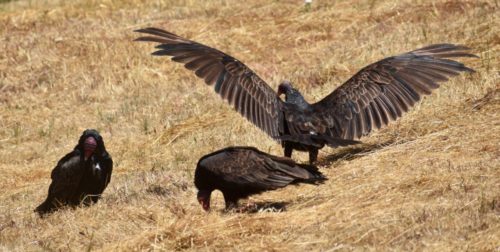
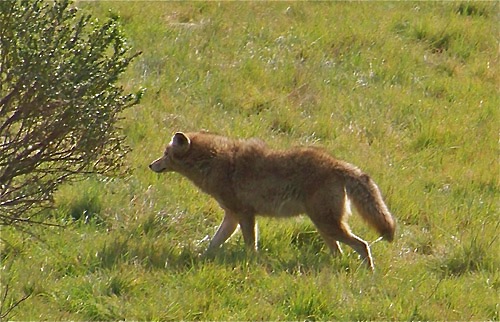
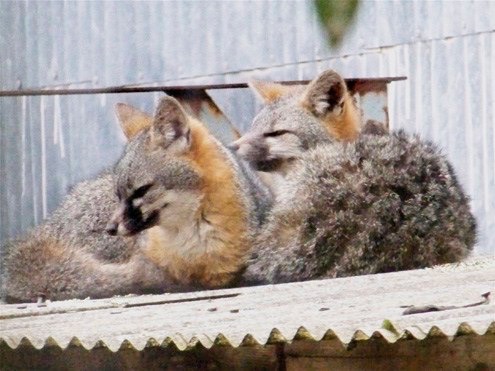
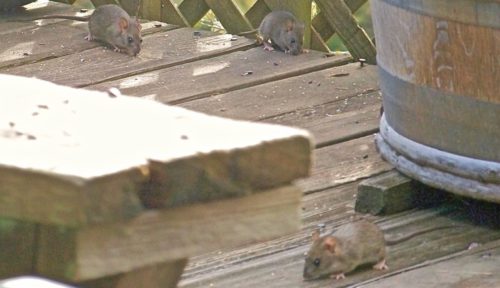
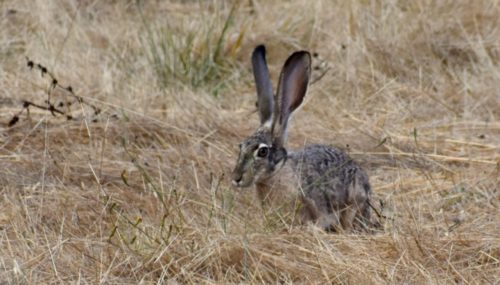
 lounge” of lizards. This is a blue-belly lizard on the wall of our cabin.
lounge” of lizards. This is a blue-belly lizard on the wall of our cabin.
